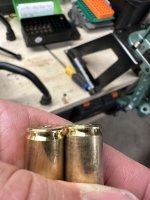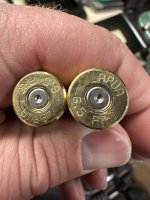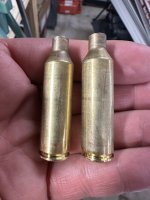Hello. I’m having an issue with my new Tikka Roughtech in 6.5 PRC. I’m in the process of load development and just started to notice an occasional sticky bolt during extraction of fired cases. There’s been no signs of pressure. Today I was testing seating depths, so every round had the same charge weight. I would say roughly 1/4 lbs f the spent cases were hard to extract. I did notice that the cases that were hard to extract has a dull finish to them whereas those that ejected smooth had the traditional glossy look to them. I chronoed everything and the was no excessive velocity to those problematic cases. These are new Lapua cases with 156gr Bergers and 56.1 grn H1000. I shot 3 shot groups resting one minute between each shot and five minutes between groups. All new cases were full length sized and trimmed prior to loading. Any ideas would be greatly appreciated.
- Thread starter Gd33333
- Start date
You are using an out of date browser. It may not display this or other websites correctly.
You should upgrade or use an alternative browser.
You should upgrade or use an alternative browser.
Sticky bolt is overpressure.
Both. But inconsistent among same charge weight.Heavy bolt lift or hard to pull the bolt back?
Heavy bolt lift or hard to pull the bolt back?
If it was overpressure wouldn’t I see signs on the case and/or primer? Why would it happen only occasionally with the same charge weight? And the velocities don’t line up with those that were sticky.Sticky bolt is overpressure.
That can be caused by a wet chamber or sizing lube left on a case.Both. But inconsistent among same charge weight.
Or cases that are too long and are impinging on the lands.
Or bullets that are jammed into the lands.
Or a dirty throat
Or a ring of carbon built up behind the lands (the dreaded carbon ring) often exacerbated by trimming too much. PS, you shouldn’t need to trim new cases. They come from the factory plenty short.
If it was overpressure wouldn’t I see signs on the case and/or primer? Why would it happen only occasionally with the same charge weight? And the velocities don’t line up with those that were sticky.
I usually see, with lapua brass, ejector stamp and cratered/flattened primers before I ever get to hard bolt lift. Your charge doesn’t seem excessive, generally. Intermittent effects are frustrating but just because it doesn’t happen every time doesn’t mean there isn’t a problem.
If it was me, I would clean the barrel really well (of carbon at least. No need to go crazy with the copper solvent. Hoppe‘s until the patches are clean will work for this.) and make sure the chamber was clean and dry. Make sure your ammo brass has no lube left on it. Take whatever seating depth seemed good (assuming it’s not jammed hard into the lands) and do a mini charge weight ladder from around 55.1…every .3 grains back to 56.1. So 3x55.1, 3x55.4, 3x55.7, 3x56.1. See if you find trouble again at the higher charges. .3 is a really small change for that big of a case but half grain changes won’t give you much to look at. If it’s pressure, you’ll see it again. If not, the problem will be gone and you can decide what else was going on.
I dont fully understand the why, but this is a problem with 6.5 PRCs. Google 6.5 PRC alex wheeler 2 reamer and you should find a pile of others with the same problem. The AW2 reamer fixes the problem. i fixed one for a friend and he hasnt had problems since.
https://longrangeonly.com/forum/threads/aw2-reamer-6-5-prc.11285/
https://longrangeonly.com/forum/threads/aw2-reamer-6-5-prc.11285/
Thanks so much for all the great info. I had planned to try loading up some 55ish grain and walk it up to see if I can notice anything. The gun was cleaned prior to this seating depth ladder test so I’m doubtful of that but will do anyway to be sure. I wiped all the cases with a towel but maybe I need to spend some more time cleaning the lube off. As far as bullet jam, I found jam and started my first group at .020 off jam and worked my way back by .015 to .110 from jam. I trimmed the cases very minimally only for consistency. This is the first time using H1000 though. I had not a single issue with my first 50 rounds through the gun using H4831SC. Hear a few pictures of spent cases from this test. Left in each pic had no issues cycling and right did. Velocities were both roughly 2870. Thanks again for the info.That can be caused by a wet chamber or sizing lube left on a case.
Or cases that are too long and are impinging on the lands.
Or bullets that are jammed into the lands.
Or a dirty throat
Or a ring of carbon built up behind the lands (the dreaded carbon ring) often exacerbated by trimming too much. PS, you shouldn’t need to trim new cases. They come from the factory plenty short.
I usually see, with lapua brass, ejector stamp and cratered/flattened primers before I ever get to hard bolt lift. Your charge doesn’t seem excessive, generally. Intermittent effects are frustrating but just because it doesn’t happen every time doesn’t mean there isn’t a problem.
If it was me, I would clean the barrel really well (of carbon at least. No need to go crazy with the copper solvent. Hoppe‘s until the patches are clean will work for this.) and make sure the chamber was clean and dry. Make sure your ammo brass has no lube left on it. Take whatever seating depth seemed good (assuming it’s not jammed hard into the lands) and do a mini charge weight ladder from around 55.1…every .3 grains back to 56.1. So 3x55.1, 3x55.4, 3x55.7, 3x56.1. See if you find trouble again at the higher charges. .3 is a really small change for that big of a case but half grain changes won’t give you much to look at. If it’s pressure, you’ll see it again. If not, the problem will be gone and you can decide what else was going on.
Attachments
New cases kind of rules out a ”Tight chamber” or ”loose sizing die” problem. The primers look great on those cases. Round edges and no cratering. I’d lean toward cleaning solution in the chamber or some cases still slick with sizing lube causing bolt thrust that looks like pressure.…and would be intermittent.
I wipe my sizing lube off with a paper towel as I don’t like to tumble after sizing but you could try 30 mins in a tumbler to make sure the sizing lube is totally gone.
Could also just be a changing pressure profile as the barrel breaks in. I’ve seen that with larger volume cartridges…load seems good until you get a couple hundred rounds then it’s suddenly too much.
Also, sometimes fired brass is closer to pressure than new…I think the initial impulse required to fireform the brass uses some of the energy of the charge. Then, with brass that’s been minimally sized and is thus close to chamber dimensions, the load has to be turned down a little.
This is all anecdotal and not verified by anyone. Some typer-sniper will be along shortly to point out the many flaws in my experience. YMMV. DON’T BLOW YOUR FACE OFF.
I wipe my sizing lube off with a paper towel as I don’t like to tumble after sizing but you could try 30 mins in a tumbler to make sure the sizing lube is totally gone.
Could also just be a changing pressure profile as the barrel breaks in. I’ve seen that with larger volume cartridges…load seems good until you get a couple hundred rounds then it’s suddenly too much.
Also, sometimes fired brass is closer to pressure than new…I think the initial impulse required to fireform the brass uses some of the energy of the charge. Then, with brass that’s been minimally sized and is thus close to chamber dimensions, the load has to be turned down a little.
This is all anecdotal and not verified by anyone. Some typer-sniper will be along shortly to point out the many flaws in my experience. YMMV. DON’T BLOW YOUR FACE OFF.
Interesting. I’ll have to do some reading. Thanks.I dont fully understand the why, but this is a problem with 6.5 PRCs. Google 6.5 PRC alex wheeler 2 reamer and you should find a pile of others with the same problem. The AW2 reamer fixes the problem. i fixed one for a friend and he hasnt had problems since.
https://longrangeonly.com/forum/threads/aw2-reamer-6-5-prc.11285/
I do see ejector marks on those cases (9 o'clock and 7 o'clock). Typically you will see pressure signs earlier than bolt stickiness but not always. As for only some cases sticking/hard it's not that unusual as you approach that point. Understand that even though we try to have each round the same each one is different, including the peak pressure. Also, to @OREGUN's point all of the items he mentioned result in overpressure.
One issue that the 6.5 PRC had originally was a difference in reamers that were using different freeborn dimensions. I don't shoot the cartridge but I remember hearing about it. I don't know if it extended into Factory rifles or not.
One issue that the 6.5 PRC had originally was a difference in reamers that were using different freeborn dimensions. I don't shoot the cartridge but I remember hearing about it. I don't know if it extended into Factory rifles or not.
I ordered some case length gauges to see exactly how much freebore I have. Hopefully that will offer up additional info. Thanks again guys. I definitely have a few things to try.I do see ejector marks on those cases (9 o'clock and 7 o'clock). Typically you will see pressure signs earlier than bolt stickiness but not always. As for only some cases sticking/hard it's not that unusual as you approach that point. Understand that even though we try to have each round the same each one is different, including the peak pressure. Also, to @OREGUN's point all of the items he mentioned result in overpressure.
One issue that the 6.5 PRC had originally was a difference in reamers that were using different freeborn dimensions. I don't shoot the cartridge but I remember hearing about it. I don't know if it extended into Factory rifles or not.
That’s what bothers me is the primers show no sign of pressure. I wouldn’t call this a hot load by any means. Would be a little disappointed if that’s the issue and I can’t even load printed max load rounds.New cases kind of rules out a ”Tight chamber” or ”loose sizing die” problem. The primers look great on those cases. Round edges and no cratering. I’d lean toward cleaning solution in the chamber or some cases still slick with sizing lube causing bolt thrust that looks like pressure.…and would be intermittent.
I wipe my sizing lube off with a paper towel as I don’t like to tumble after sizing but you could try 30 mins in a tumbler to make sure the sizing lube is totally gone.
Could also just be a changing pressure profile as the barrel breaks in. I’ve seen that with larger volume cartridges…load seems good until you get a couple hundred rounds then it’s suddenly too much.
Also, sometimes fired brass is closer to pressure than new…I think the initial impulse required to fireform the brass uses some of the energy of the charge. Then, with brass that’s been minimally sized and is thus close to chamber dimensions, the load has to be turned down a little.
This is all anecdotal and not verified by anyone. Some typer-sniper will be along shortly to point out the many flaws in my experience. YMMV. DON’T BLOW YOUR FACE OFF.
Where are you getting this isn’t max load? Hogden has H1000 max as 55gr with a 153 and your 56.1 with a 156.
The primers aren't showing, but you have every single other sign...That’s what bothers me is the primers show no sign of pressure. I wouldn’t call this a hot load by any means. Would be a little disappointed if that’s the issue and I can’t even load printed max load rounds.
Do we need to make another sign for you?
That’s what bothers me is the primers show no sign of pressure. I wouldn’t call this a hot load by any means. Would be a little disappointed if that’s the issue and I can’t even load printed max load rounds.
As for the signs of pressure, the ones we use tell us that we are over the pressure that the individual component (case, primer) is suited for. It is a very good indication that the load exceeds SAAMI rating. If you intend to run overpressure then you seek a component that doesn't indicate that overpressure. You may change primers seeking a harder primer cup or change brass. In this case your are exceeding the pressure capability of the case/chamber interface. The cause of a sticky bolt is the case expanding to fill the chamber and the case and barrel/action expanding due to maximum pressure. Because of the different properties of the steel and brass if the expansion is enough the brass will not shrink enough when the pressure returns to normal under no pressure. When you reach the point of a sticky or stuck case you well beyond the capability of the case/action to operate effectively.
There are certain conditions that cause sticky bolts that can such as case/chamber roughness than can create this issue but it's unlikely to be an issue if only some rounds have the issue.
You keep mentioning book max. Where are you getting your load data?
The primers aren't showing, but you have every single other sign...
Do we need to make another sign for you?

Requested load data from Berger. 56.1 H1000 is max load.Where are you getting this isn’t max load? Hogden has H1000 max as 55gr with a 153 and your 56.1 with a 156.
Thanks for the info. The load data was given to me by Berger where they list 56.1 H1000 as the max load using 156gr bullets. I will be loading up some with 55 gr H1000 next to see if I get similar results.As for the signs of pressure, the ones we use tell us that we are over the pressure that the individual component (case, primer) is suited for. It is a very good indication that the load exceeds SAAMI rating. If you intend to run overpressure then you seek a component that doesn't indicate that overpressure. You may change primers seeking a harder primer cup or change brass. In this case your are exceeding the pressure capability of the case/chamber interface. The cause of a sticky bolt is the case expanding to fill the chamber and the case and barrel/action expanding due to maximum pressure. Because of the different properties of the steel and brass if the expansion is enough the brass will not shrink enough when the pressure returns to normal under no pressure. When you reach the point of a sticky or stuck case you well beyond the capability of the case/action to operate effectively.
There are certain conditions that cause sticky bolts that can such as case/chamber roughness than can create this issue but it's unlikely to be an issue if only some rounds have the issue.
You keep mentioning book max. Where are you getting your load data?
Start low and work up regardless of published data, that max load isn't gonna be the same for every rifle or lot of powder.
I'd back off to about 50 and work up just based on what's provided in this thread.
I'd back off to about 50 and work up just based on what's provided in this thread.
Must be a SH memberRequested load data from Berger. 56.1 H1000 is max load.
Similar threads
- Replies
- 10
- Views
- 475



